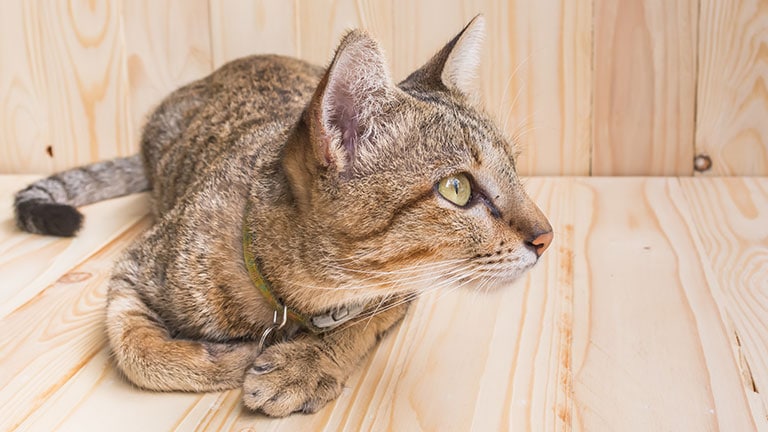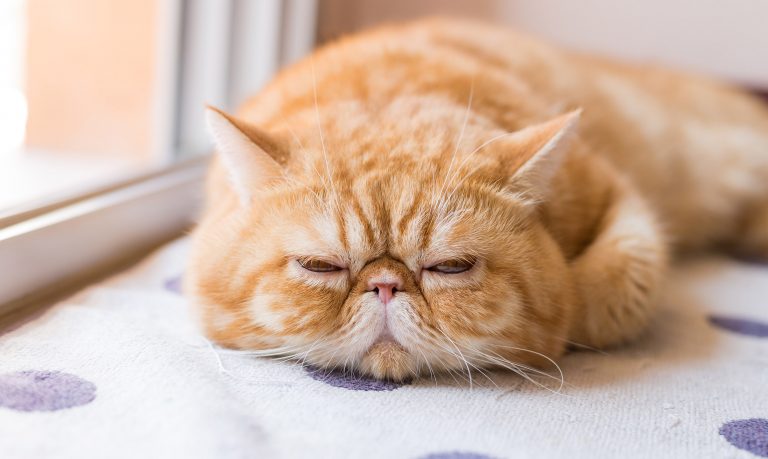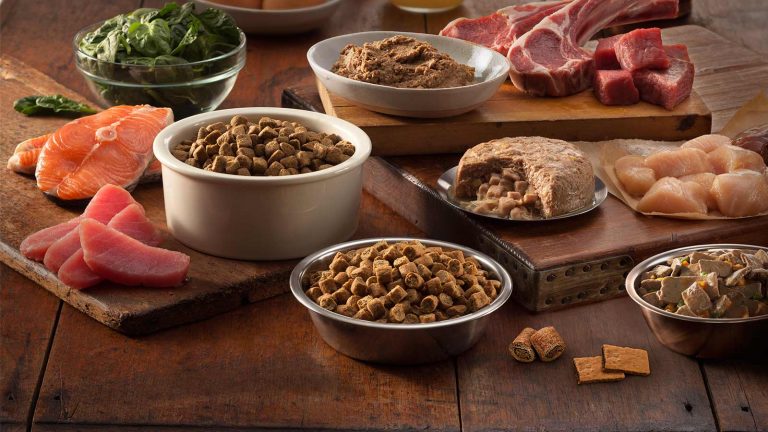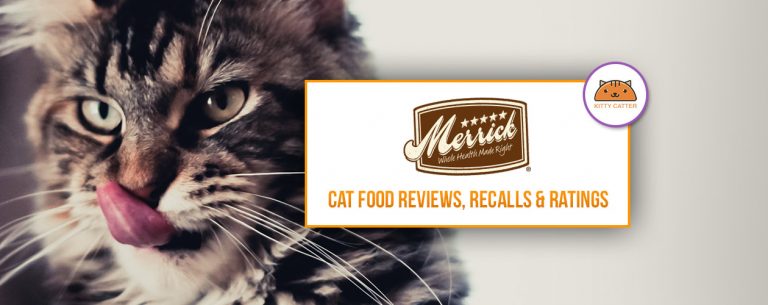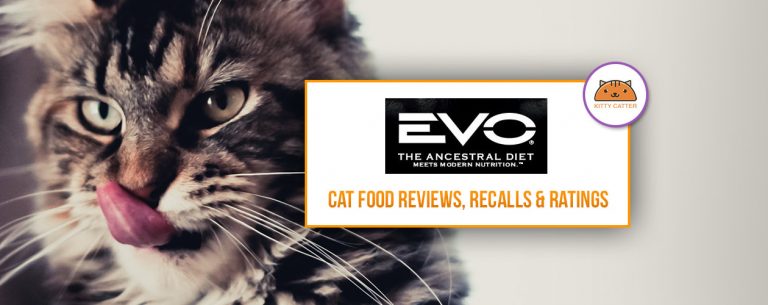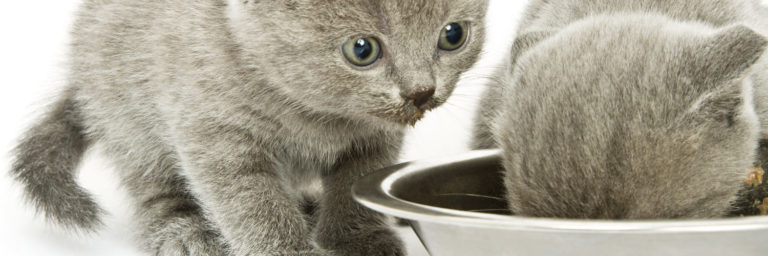Best Cat Food For Kidney Disease – Top Prescription & Non-Prescription Choices
Contents of Article
- What is the Best Cat Food for Kidney Disease?
- Should you give your cat a prescription food for kidney disease?
- You’ll look for the same nutritional qualities in any food for cats with kidney disease, whether it’s a prescription diet or not.
- Prescription Canned Cat Food for Kidney Disease – Top 3 Picks
- Non-Prescription Wet Cat Food for Kidney Disease – Top 3 Picks
- It’s paramount that your cat eats something.
The information provided in this article is the result of hours of research, a call with a veterinarian, and communication with guardians of cats diagnosed with CKD. It’s for informational purposes only and isn’t a substitute for veterinary advice.
There are some requirements and rules to follow when feeding your cat if he or she suffers from kidney disease. We know how important it is to maintain our pet’s quality of life, so we have compiled a list of foods that, through our research, we think will help your cat be healthy and happy.
Before our list of the best prescription and non-prescription foods for cats with kidney disease, we will tackle some of the important questions that you might have about your cat’s diet.
What is the Best Cat Food for Kidney Disease?
- Royal Canin Veterinary Diet Renal Support D Morsels in Gravy Canned Cat Food
- Hill’s Prescription Diet k/d Kidney Care with Chicken Canned Cat Food
- Purina Pro Plan Veterinary Diets NF Kidney Function Advanced Care Formula Canned Cat Food
- Hi-Tor Neo Diet For Cats
- Blue Natural Veterinary Diet KM Kidney + Mobility Support Canned Cat Food
- Smalls for Smalls
- NomNomNow Chicken Cat Food
Should you give your cat a prescription food for kidney disease?
Both prescription and non-prescription foods can help cats with chronic kidney disease. Regardless of whether your cat’s food requires a vet’s approval, it should have several key qualities, including high calorie density, appropriate protein, and low phosphorus.
Prescription foods tend to tick more of the CKD management boxes, but most of them also contain ingredients that you might never otherwise give your cat. This gives you a few options.
- Choose a prescription food and hold your nose over its plant protein sources, artificial flavors, and added sugar.
- Find an acceptable commercial food that your cat enjoys, but which doesn’t follow the standard rules for cats with kidney disease.
- Preferably under a veterinarian or animal nutritionist’s guidance, make your own food that satisfies all of your requirements.
Making homemade food for your cat with kidney disease is beyond the scope of this article, but we will recommend both prescription and non-prescription cat foods, detailing how each product measures up to CKD-specific dietary needs.
You’ll look for the same nutritional qualities in any food for cats with kidney disease, whether it’s a prescription diet or not.
High Quality Protein
When protein breaks down during digestion, it produces waste products. Normally, these are filtered out by the kidneys and move safely out of your cat’s body and into the litter box. But when kidney function declines, your cat’s inner waste processing plant becomes less and less effective. Instead of passing out through the urine, waste products will remain in the blood system, making your cat feel unwell.
Traditionally, protein has been restricted to reduce BUN (blood urea nitrogen) levels, but newer research suggests that restricting protein does more harm than good. Many veterinarians worry that protein restriction will only perpetuate muscle wasting and declining health.
Instead, some recommend high-quality protein (preferably in canned or wet form). For cats, this means a diet rich in protein from fresh animal sources like human-grade muscle meat and organs. Meat by-products have mixed bioavailability values and plant protein creates too much waste. A diet packed with easy-to-digest, efficiently metabolized protein supports lean muscle mass while placing less strain on the organs.
Ultimately, no one is in agreement on the protein restriction issue. Talk to your veterinarian and do your own research, but this is a decision you’ll need to make for yourself. Consider experimenting with different foods and observing your cat closely to determine which makes her feel the best.
Low Phosphorus
When your cat’s kidneys aren’t functioning fully, phosphorus filtration is impeded. When phosphorus starts to build up in the bloodstream instead of passing out of the body, it makes your cat feel sick and fuels further kidney decline. Since you can’t restore kidney function once it’s lost, the best way to counteract this effect is by limiting your cat’s phosphorus intake.
The best food for cats with CKD is less than 0.5% phosphorus on a dry matter basis.
Low Sodium
High sodium diets can increase blood pressure, worsening kidney damage. A low-sodium can help to reduce kidney strain, slow disease progression, and make your cat to feel better.
High Moisture Content
Cats with kidney disease tend to lose a lot of water in the litter box and are prone to dehydration. A high-moisture diet helps to prevent dehydration.
Omega-3 Fatty Acids
Kidney disease is frequently accompanied by nephritis, or inflammation of the kidneys. Omega-3 fatty acids from fish or krill help to minimize inflammation and help your cat to feel more comfortable.
B Vitamins
Kidney disease causes cats to urinate on a very regular basis, meaning that crucial B vitamins often pass out of their body and into the litter box. As a result, your cat may develop a vitamin B deficiency. This deficiency results in a reduced appetite, low energy, and generally poor health. Some prescription foods contain additional B vitamins to help your cat feel better.
Probiotics
Because reduced kidney function can lead to toxin buildup in the gut, probiotics can help to perform something called “enteric dialysis”. This is when bacteria, instead of the kidneys, detoxify the body. Azodyl is a synergized prebiotic and probiotic supplement made and sold for cats with kidney disease.
Prescription Canned Cat Food for Kidney Disease – Top 3 Picks
Now that we’ve discussed the key qualities of the best cat food for kidney disease, here are a few specific product recommendations. The following are prescription foods and are only available with a veterinarian’s written approval.
Royal Canin Veterinary Diet Renal Support D Morsels in Gravy Canned Cat Food Review
First 5 Ingredients: Water Sufficient for Processing, Chicken By-Products, Chicken Liver, Pork Liver, Wheat Flour
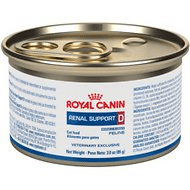
Royal Canin is one of the few brands that’s consistently recommended by veterinarians. This recipe has a “morsels in gravy” texture and was formulated specifically for cats with kidney disease.
It’s calorie-dense to ensure that your cat receives plenty of nourishment in each bite, and according to Royal Canin, has an “enhanced aromatic profile and texture” to encourage sick cats to eat. Customer reviews support this claim, saying that their finicky cats enjoy the taste and texture.
The food is 30% protein and 0.44% phosphorus on a dry matter basis. It’s supplemented with
It’s made with omega-3 fatty acids EPA and DHA to minimize inflammation and support kidney health. – Buy It
Pros
- Maximized energy density
- Low phosphorus levels
- Contains omega-3 fatty acids
- Low phosphorus levels help your cat to feel better
- Controlled protein levels to reduce uremic toxins
Cons
- Contains objectionable ingredients like corn flour and wheat flour
Hill’s Prescription Diet k/d Kidney Care with Chicken Canned Cat Food Review
First 5 Ingredients: Water, Pork Liver, Chicken, Egg Product, Brewers Rice
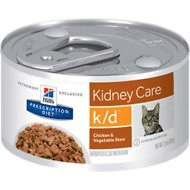
This prescription diet from Hill’s is formulated and clinically tested to “improve and lengthen the quality of life” among cats with kidney disease. The food is made to stimulate appetite and increase caloric intake.
Customer reviews suggest that this is true. The food has a 4.2 out of 5 star rating on Chewy and 86% of customers say they’d recommend it to a friend.
It has controlled phosphorus levels at 0.49% on a dry matter basis. It is 30% protein on a dry matter basis, along with added omega-3 fatty acids and therapeutic levels of l-carnitine, an amino acid that is often depleted in renal disease patients. – Buy It
Pros
- Controlled phosphorus levels
- Added omega-3 fatty acids
- Added l-carnitine to improve wellbeing
- Calorie-dense
- Highly palatable
Cons
- Contains sugar
- Contains caramel color
Purina Pro Plan Veterinary Diets NF Kidney Function Advanced Care Formula Canned Cat Food Review
First 5 Ingredients: Water Sufficient For Processing, Beef, Poultry By-Products, Rice, Meat By-Products
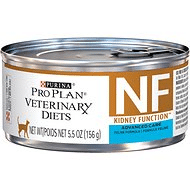
This veterinary diet from Purina is formulated with low phosphorus, controlled levels of protein, and is relatively calorie-dense to support a healthy weight. It contains fish oil as a natural source of omega-3 fatty acids, reduced sodium to reduce kidney burden, and added B-vitamins.
According to customer reviews, the pate-style formula is palatable and appetizing for sick cats.
On a dry matter basis, the formula is approximately 0.49% phosphorus and 34% protein. – Buy It
Pros
- Low in phosphorus
- Highly palatable
- Added omega-3 fatty acids
- Supplemented with B vitamins
- Calorie dense to support lean body mass
Cons
- Contains carrageenan, which may contribute to inflammation
- Contains rice
Non-Prescription Wet Cat Food for Kidney Disease – Top 3 Picks
Hi-Tor Neo Diet For Cats Review
First 5 Ingredients: Sufficient Water for Processing, Meat By-Products, Chicken, Animal Liver, Beef
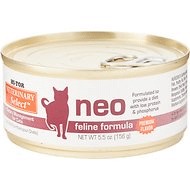
Though this food is available without a prescription, but it is formulated for cats with kidney disease. It’s made for those who might want a prescription diet, but who aren’t in contact with a veterinarian or don’t want to pay top dollar for a prescription food.
At about 0.71% on a dry matter basis, this food is not as phosphorus-restricted as some of the other foods on this list. It has restricted protein at 36% on a dry matter basis.
In addition to restricted phosphorus, the food has limited sodium to reduce kidney strain.
Pros
- Somewhat restricted phosphorus
- Low sodium
- Relatively palatable
- Calorie dense to support healthy muscle mass
Cons
- Lacks omega-3 fatty acid supplementation
- Higher in phosphorus than other CKD-focused foods
Blue Natural Veterinary Diet KM Kidney + Mobility Support Canned Cat Food Review
First 5 Ingredients: Chicken, Chicken Broth, Water, Potatoes, Potato Starch
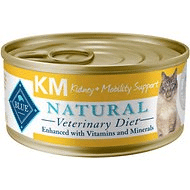
Although this food is called a “Veterinary Diet”, you can purchase it without a veterinarian’s prescription. In addition to standard renal diet features, this food is formulated with glucosamine and chondroitin for joint health support.
The pate-style food gets mixed taste test results – a notable percentage of reviewers say that their cats didn’t like the food.
Compared to other renal care products, this food has slightly more phosphorus and less protein on a dry matter basis. It’s .77% phosphorus on a dry matter basis and about 28% protein. – Buy It
Pros
- Restricted phosphorus content
- Added omega-3 fatty acids
- Supports joint health
Cons
- Contains carrageenan, which may increase inflammation
- Higher in phosphorus than some other foods
Smalls for Smalls Fresh Chicken Minced Cat Food Review
First 5 Ingredients: Chicken Thigh, Chicken Breast, Chicken Liver, Green Beans, Peas

Smalls for Smalls makes fresh cat food that is carefully formulated for your cat based on a profile you create when you sign up. Smalls for Smalls recipes have high protein content because cats are primarily carnivores and get most of their nutrition from meat. They also have high water content, because cats rely on their food to help them stay hydrated. Smalls for Smalls says that if the ingredients wouldn’t be good enough for humans to eat, then they don’t deem it good enough for your cat, either–something you can feel great about! They gently cook all their recipes so the nutrition is locked in, and the benefits are numerous.
Because cats are primarily carnivores, most of their nutrition should come from meat, and in Smalls for Smalls recipes, they do just that. If you want to provide your cat with a wholesome meal with ingredients you can trust, Smalls for Smalls is a great choice.
Smalls for Smalls allows you to get back to nature with human grade, high-protein, high-moisture fresh recipe, formulated to be the healthiest food your cat can eat. Real, fresh chicken meat and a small bit of green veg means more energy, a softer coat, and a less fragrant litter box.
Pros
- Low phosphorus content
- Human-grade ingredients
- Free from synthetic additives
- Customized profile allows you to input information about your cat
Cons
- It is more expensive than other foods
- It is a subscription service
NomNomNow Chicken Cat Food Review
First 5 Ingredients: Chicken Breast, Thigh, and Liver, Asparagus, Carrot, Spinach, Cantaloupe
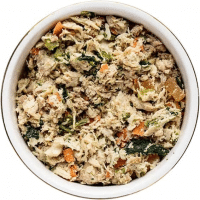
NomNomNow cat food is different from the other foods on this list.
The company makes fresh food in small batches and ships them straight to your door on a monthly or weekly basis. The foods aren’t specially formulated for cats with kidney disease, but they are rich in high-quality animal protein and have a highly-palatable taste and texture.
The biggest advantage of NomNomNow for cats with CKD, however, isn’t simply the quality of the foods. It’s the fact that NomNomNow gives you personal access to a team of pet nutrition experts willing to help you find the perfect food for your cat.
If you’re not sure if NomNomNow is the right choice for you, the company encourages you to email them at care@nomnomnow.com and send them your cat’s most recent lab results. The company’s nutrition experts will evaluate your cat’s situation and give you personalized advice.
If something changes along the way, you can always contact your account manager to ask questions or change your subscription.
NomNomNow’s Chicken Chow Meow recipe is approximately 0.26% phosphorus by weight. – Buy It
Pros
- Low phosphorus content
- Fresh, high-quality protein sources
- Free from synthetic additives
- Connects you to an account manager who can help you choose the right food
Cons
- You’ll have to sign up to a subscription service, which can be frustrating if your cat doesn’t like the food
It’s paramount that your cat eats something.
From Dr. David J. Polzin, DVM, PhD, DACVIM’s “11 guidelines for conservatively treating chronic kidney disease”:
“In many or most dogs and cats with chronic kidney disease, death or euthanasia results directly or indirectly from starvation.”
Feeding a cat with kidney disease is an exasperating dance between finding foods your cat will willingly eat and choosing foods that won’t tax the kidneys. Your cat may enjoy their prescription food for a few weeks and then reject it. She might only eat a food that’s high in phosphorus and refuse everything else.
To increase your chances of success, make dietary changes while your cat still has an appetite. Cats in the later stages of kidney failure might feel too sick to try something new.
If your cat becomes extremely finicky and refuses to eat multiple meals at a time, nutritional rules can go out of the window, at least temporarily. Cats with kidney disease might eat baby food, plain chicken breast, Temptations treats, liver, Fancy Feast, or bonito flakes. All of these are better than nothing.

